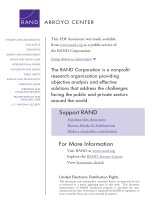decision-making the essence of the manager’s job
Bạn đang xem bản rút gọn của tài liệu. Xem và tải ngay bản đầy đủ của tài liệu tại đây (528.67 KB, 38 trang )
ninth edition
STEPHEN P. ROBBINS
© 2007 Prentice Hall, Inc.
© 2007 Prentice Hall, Inc.
All rights reserved.
All rights reserved.
PowerPoint Presentation by Charlie Cook
PowerPoint Presentation by Charlie Cook
The University of West Alabama
The University of West Alabama
MARY COULTER
Decision-Making:
Decision-Making:
The Essence of
The Essence of
the Manager’s Job
the Manager’s Job
Chapter
Chapter
6
6
© 2007 Prentice Hall, Inc. All rights
reserved. 6–2
L E A R N I N G O U T L I N E
L E A R N I N G O U T L I N E
Follow this Learning Outline as you read and study this chapter.
Follow this Learning Outline as you read and study this chapter.
The Decision-Making Process
The Decision-Making Process
•
Define decision and decision-making process.
Define decision and decision-making process.
•
Describe the eight steps in the decision-making process.
Describe the eight steps in the decision-making process.
The Manager as Decision Maker
The Manager as Decision Maker
•
Discuss the assumptions of rational decision making.
Discuss the assumptions of rational decision making.
•
Describe the concepts of bounded rationality, satisficing,
Describe the concepts of bounded rationality, satisficing,
and escalation of commitment.
and escalation of commitment.
•
Explain intuitive decision making.
Explain intuitive decision making.
•
Contrast programmed and nonprogrammed decisions.
Contrast programmed and nonprogrammed decisions.
© 2007 Prentice Hall, Inc. All rights
reserved. 6–3
L E A R N I N G O U T L I N E (cont’d)
L E A R N I N G O U T L I N E (cont’d)
Follow this Learning Outline as you read and study this chapter.
Follow this Learning Outline as you read and study this chapter.
The Manager as Decision Maker (cont’d)
The Manager as Decision Maker (cont’d)
•
Contrast the three decision-making conditions.
Contrast the three decision-making conditions.
•
Explain maximax, maximin, and minimax decision choice
Explain maximax, maximin, and minimax decision choice
approaches.
approaches.
•
Describe the four decision making styles.
Describe the four decision making styles.
•
Discuss the twelve decision-making biases managers
Discuss the twelve decision-making biases managers
may exhibit.
may exhibit.
•
Describe how manager can deal with the negative effects
Describe how manager can deal with the negative effects
of decision errors and biases.
of decision errors and biases.
•
Explain the managerial decision-making model.
Explain the managerial decision-making model.
© 2007 Prentice Hall, Inc. All rights
reserved. 6–4
L E A R N I N G O U T L I N E (cont’d)
L E A R N I N G O U T L I N E (cont’d)
Follow this Learning Outline as you read and study this chapter.
Follow this Learning Outline as you read and study this chapter.
Decision Making for Today’s World
Decision Making for Today’s World
•
Explain how managers can make effective decisions in
Explain how managers can make effective decisions in
today’s world.
today’s world.
•
List six characteristics of an effective decision-making
List six characteristics of an effective decision-making
process.
process.
•
Describe the five habits of highly reliable organizations.
Describe the five habits of highly reliable organizations.
© 2007 Prentice Hall, Inc. All rights
reserved. 6–5
Decision Making
Decision Making
•
Decision
Decision
Making a choice from two or more alternatives.
Making a choice from two or more alternatives.
•
The Decision-Making Process
The Decision-Making Process
Identifying a problem and decision criteria and
Identifying a problem and decision criteria and
allocating weights to the criteria.
allocating weights to the criteria.
Developing, analyzing, and selecting an alternative
Developing, analyzing, and selecting an alternative
that can resolve the problem.
that can resolve the problem.
Implementing the selected alternative.
Implementing the selected alternative.
Evaluating the decision’s effectiveness.
Evaluating the decision’s effectiveness.
© 2007 Prentice Hall, Inc. All rights
reserved. 6–6
Exhibit 6–1
Exhibit 6–1
The Decision-Making Process
The Decision-Making Process
© 2007 Prentice Hall, Inc. All rights
reserved. 6–7
Step 1: Identifying the Problem
Step 1: Identifying the Problem
•
Problem
Problem
A discrepancy between an existing and desired state
A discrepancy between an existing and desired state
of affairs.
of affairs.
•
Characteristics of Problems
Characteristics of Problems
A problem becomes a problem when a manager
A problem becomes a problem when a manager
becomes aware of it.
becomes aware of it.
There is pressure to solve the problem.
There is pressure to solve the problem.
The manager must have the authority, information, or
The manager must have the authority, information, or
resources needed to solve the problem.
resources needed to solve the problem.
© 2007 Prentice Hall, Inc. All rights
reserved. 6–8
Step 2: Identifying Decision Criteria
Step 2: Identifying Decision Criteria
•
Decision criteria are factors that are important
Decision criteria are factors that are important
(relevant) to resolving the problem.
(relevant) to resolving the problem.
Costs that will be incurred (investments required)
Costs that will be incurred (investments required)
Risks likely to be encountered (chance of failure)
Risks likely to be encountered (chance of failure)
Outcomes that are desired (growth of the firm)
Outcomes that are desired (growth of the firm)
Step 3: Allocating Weights to the Criteria
Step 3: Allocating Weights to the Criteria
•
Decision criteria are not of equal importance:
Decision criteria are not of equal importance:
Assigning a weight to each item places the items in
Assigning a weight to each item places the items in
the correct priority order of their importance in the
the correct priority order of their importance in the
decision making process.
decision making process.
© 2007 Prentice Hall, Inc. All rights
reserved. 6–9
Exhibit 6–2
Exhibit 6–2
Criteria and Weights for Computer Replacement Decision
Criteria and Weights for Computer Replacement Decision
Criterion
Weight
Memory and Storage 10
Battery life 8
Carrying Weight 6
Warranty 4
Display Quality 3
© 2007 Prentice Hall, Inc. All rights
reserved. 6–10
Step 4: Developing Alternatives
Step 4: Developing Alternatives
•
Identifying viable alternatives
Identifying viable alternatives
Alternatives are listed (without evaluation) that can
Alternatives are listed (without evaluation) that can
resolve the problem.
resolve the problem.
Step 5: Analyzing Alternatives
Step 5: Analyzing Alternatives
•
Appraising each alternative’s strengths and
Appraising each alternative’s strengths and
weaknesses
weaknesses
An alternative’s appraisal is based on its ability to
An alternative’s appraisal is based on its ability to
resolve the issues identified in steps 2 and 3.
resolve the issues identified in steps 2 and 3.
© 2007 Prentice Hall, Inc. All rights
reserved. 6–11
Exhibit 6–3
Exhibit 6–3
Assessed Values of Laptop Computers
Assessed Values of Laptop Computers
Using Decision Criteria
Using Decision Criteria
© 2007 Prentice Hall, Inc. All rights
reserved. 6–12
Step 6: Selecting an Alternative
Step 6: Selecting an Alternative
•
Choosing the best alternative
Choosing the best alternative
The alternative with the highest total weight is
The alternative with the highest total weight is
chosen.
chosen.
Step 7: Implementing the Alternative
Step 7: Implementing the Alternative
•
Putting the chosen alternative into action.
Putting the chosen alternative into action.
Conveying the decision to and gaining commitment
Conveying the decision to and gaining commitment
from those who will carry out the decision.
from those who will carry out the decision.
© 2007 Prentice Hall, Inc. All rights
reserved. 6–13
Exhibit 6–4
Exhibit 6–4
Evaluation of Laptop Alternatives
Evaluation of Laptop Alternatives
Against Weighted Criteria
Against Weighted Criteria
© 2007 Prentice Hall, Inc. All rights
reserved. 6–14
Step 8: Evaluating the Decision’s
Step 8: Evaluating the Decision’s
Effectiveness
Effectiveness
•
The soundness of the decision is judged by its
The soundness of the decision is judged by its
outcomes.
outcomes.
How effectively was the problem resolved by
How effectively was the problem resolved by
outcomes resulting from the chosen alternatives?
outcomes resulting from the chosen alternatives?
If the problem was not resolved, what went wrong?
If the problem was not resolved, what went wrong?
© 2007 Prentice Hall, Inc. All rights
reserved. 6–15
Exhibit 6–5
Exhibit 6–5
Decisions in the Management Functions
Decisions in the Management Functions
© 2007 Prentice Hall, Inc. All rights
reserved. 6–16
Making Decisions
Making Decisions
•
Rationality
Rationality
Managers make consistent, value-maximizing choices
Managers make consistent, value-maximizing choices
with specified constraints.
with specified constraints.
Assumptions are that decision makers:
Assumptions are that decision makers:
Are perfectly rational, fully objective, and logical.
Are perfectly rational, fully objective, and logical.
Have carefully defined the problem and identified all viable
Have carefully defined the problem and identified all viable
alternatives.
alternatives.
Have a clear and specific goal
Have a clear and specific goal
Will select the alternative that maximizes outcomes in the
Will select the alternative that maximizes outcomes in the
organization’s interests rather than in their personal interests.
organization’s interests rather than in their personal interests.
© 2007 Prentice Hall, Inc. All rights
reserved. 6–17
Exhibit 6–6
Exhibit 6–6
Assumptions of Rationality
Assumptions of Rationality
© 2007 Prentice Hall, Inc. All rights
reserved. 6–18
Making Decisions (cont’d)
Making Decisions (cont’d)
•
Bounded Rationality
Bounded Rationality
Managers make decisions rationally, but are limited
Managers make decisions rationally, but are limited
(bounded) by their ability to process information.
(bounded) by their ability to process information.
Assumptions are that decision makers:
Assumptions are that decision makers:
Will not seek out or have knowledge of all alternatives
Will not seek out or have knowledge of all alternatives
Will
Will
satisfy
satisfy
—choose the first alternative encountered that
—choose the first alternative encountered that
satisfactorily solves the problem—
satisfactorily solves the problem—
rather than maximize the
rather than maximize the
outcome of their decision by considering all alternatives and
outcome of their decision by considering all alternatives and
choosing the best.
choosing the best.
Influence on decision making
Influence on decision making
Escalation of commitment: an increased commitment to a
Escalation of commitment: an increased commitment to a
previous decision despite evidence that it may have been
previous decision despite evidence that it may have been
wrong.
wrong.
© 2007 Prentice Hall, Inc. All rights
reserved. 6–19
The Role of Intuition
The Role of Intuition
•
Intuitive decision making
Intuitive decision making
Making decisions on the basis of experience, feelings,
Making decisions on the basis of experience, feelings,
and accumulated judgment.
and accumulated judgment.
© 2007 Prentice Hall, Inc. All rights
reserved. 6–20
Exhibit 6–7
Exhibit 6–7
What is Intuition?
What is Intuition?
Source: Based on L. A. Burke and M. K. Miller, “Taking the Mystery Out of Intuitive
Decision Making,” Academy of Management Executive, October 1999, pp. 91–99.
© 2007 Prentice Hall, Inc. All rights
reserved. 6–21
Types of Problems and Decisions
Types of Problems and Decisions
•
Structured Problems
Structured Problems
Involve goals that clear.
Involve goals that clear.
Are familiar (have occurred before).
Are familiar (have occurred before).
Are easily and completely defined
Are easily and completely defined
—infor
—infor
mation about
mation about
the problem is available and complete.
the problem is available and complete.
•
Programmed Decision
Programmed Decision
A repetitive decision that can be handled by a routine
A repetitive decision that can be handled by a routine
approach.
approach.
© 2007 Prentice Hall, Inc. All rights
reserved. 6–22
Types of Programmed Decisions
Types of Programmed Decisions
•
Policy
Policy
A general guideline for making a decision about a
A general guideline for making a decision about a
structured problem.
structured problem.
•
Procedure
Procedure
A series of interrelated steps that a manager can use
A series of interrelated steps that a manager can use
to respond (applying a policy) to a structured problem.
to respond (applying a policy) to a structured problem.
•
Rule
Rule
An explicit statement that limits what a manager or
An explicit statement that limits what a manager or
employee can or cannot do.
employee can or cannot do.
© 2007 Prentice Hall, Inc. All rights
reserved. 6–23
Policy, Procedure, and Rule Examples
Policy, Procedure, and Rule Examples
•
Policy
Policy
Accept all customer-returned merchandise.
Accept all customer-returned merchandise.
•
Procedure
Procedure
Follow all steps for completing merchandise return
Follow all steps for completing merchandise return
documentation.
documentation.
•
Rules
Rules
Managers must approve all refunds over $50.00.
Managers must approve all refunds over $50.00.
No credit purchases are refunded for cash.
No credit purchases are refunded for cash.
© 2007 Prentice Hall, Inc. All rights
reserved. 6–24
Problems and Decisions (cont’d)
Problems and Decisions (cont’d)
•
Unstructured Problems
Unstructured Problems
Problems that are new or unusual and for which
Problems that are new or unusual and for which
information is ambiguous or incomplete.
information is ambiguous or incomplete.
Problems that will require custom-made solutions.
Problems that will require custom-made solutions.
•
Nonprogrammed Decisions
Nonprogrammed Decisions
Decisions that are unique and nonrecurring.
Decisions that are unique and nonrecurring.
Decisions that generate unique responses.
Decisions that generate unique responses.
© 2007 Prentice Hall, Inc. All rights
reserved. 6–25
Exhibit 6–8
Exhibit 6–8
Programmed versus Nonprogrammed Decisions
Programmed versus Nonprogrammed Decisions









